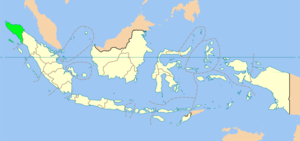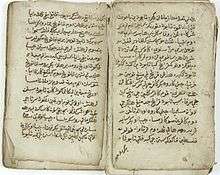Acehnese language
| Acehnese | |
|---|---|
|
Bahsa/Basa Acèh بهسا اچيه | |
| Pronunciation | [bahsa at͡ʃeh] |
| Native to | Indonesia |
| Region | Aceh, Sumatra |
| Ethnicity | Acehnese |
Native speakers | 3.5 million (2000 census)[1] |
|
Latin Arabic | |
| Language codes | |
| ISO 639-3 |
ace |
| Glottolog |
achi1257[2] |
 Aceh province, Sumatra | |
The Acehnese language (Jawi: بهسا اچيه) is a Malayo-Polynesian language spoken by Acehnese people natively in Aceh, Sumatra, Indonesia. This language is also spoken by Acehnese descendants in some parts of Malaysia like Yan, in Kedah.
Name
As of 1988, "Acehnese" is the modern English name spelling and the bibliographical standard, and Acehnese people use the spelling "Acehnese" when writing in English. "Achinese" is an antiquated spelling of the English language tradition. "Atjehnese" is the Dutch spelling and an outdated Indonesian one. The spelling "Achehnese" originates from a 1906 English translation of the Dutch language Studien over atjesche klank- en schriftleer. Tijdschrift voor Indische Taal-, Land- en Volkenkunde 35.346-442 by Christiaan Snouck Hurgronje, 1892. In Acehnese the language is called Basa/Bahsa Acèh. In Indonesian it is called Bahasa Aceh.[3]
Classification and related languages
Acehnese belongs to the Malayo-Polynesian branch of Austronesian. Acehnese's closest relatives are the other Chamic languages, which are principally spoken in Vietnam. The closest relative of the Chamic family is the Malay language family, which includes languages also spoken in Sumatra such as Gayo, the Batak languages and Minangkabau as well as the national language, Indonesian.
Paul Sidwell notes that Acehnese likely has an Austroasiatic substratum.[4]
Distribution
Acehnese language is located primarily in coastal region of Aceh. This language is spoken in 13 regencies and 4 cities in Aceh, those are:
City
North-East Coast
- Aceh Besar
- Pidie
- Pidie Jaya
- Bireuen
- Aceh Utara
- Aceh Timur (except in 3 subdistricts, Serba Jadi, Peunaron and Simpang Jernih where Gayo language is spoken)
- Aceh Tamiang (Mostly Manyak Payet and Kuala Simpang subdistrict, the rest of the district speaks a variety of the Malay language)
West-South Coast
- Aceh Jaya
- West Aceh
- Nagan Raya
- Southwest Aceh (except in subdistrict Susoh where Aneuk Jamee language is spoken)
- South Aceh (mixed with Kluet language and Aneuk Jamee language)
Phonology
Oral monophthong vowels in Acehnese are shown in the table below.[5]
| Close | i | ɨ~ɯ | u |
|---|---|---|---|
| Close-mid | e | ə | o |
| Open-mid | ɛ | ʌ | ɔ |
| Open | a |
In addition to the modern 26 letter basic Latin alphabet, Acehnese uses the supplementary letters è, é, ë, ô, and ö, making a total of 31 letters in its orthography.

The table below shows the Acehnese consonant phonemes and the range of their realizations.[6]
| Labial | Labio- dental |
Alveolar | Post- alveolar |
Palatal | Velar | Glottal | ||||||||
|---|---|---|---|---|---|---|---|---|---|---|---|---|---|---|
| Stop | p | b | t | d | c | ɟ | k | ɡ | ʔ | |||||
| Nasal | m | n | ɲ | ŋ | ||||||||||
| Post-stopped nasal | mᵇ | nᵈ | ɲᶡ | ŋᶢ | ||||||||||
| Trill | r | |||||||||||||
| Fricative | f | s | z | ʃ | h | |||||||||
| Approximant (Lateral) |
j | w | ||||||||||||
| l | ||||||||||||||
Notes:
- Syllable-final orthographic ⟨k⟩ always represents /ʔ/ save in certain recent loans
- /f/, /z/, and /ʃ/ are borrowed sounds, and are often replaced by ph, dh, and ch respectively
- The post-stopped nasals (orally released nasals) have been called "funny nasals".[7] They are distinct from the nasal-stop sequences /mb/, /nd/, /ɲɟ/, /ŋɡ/, e.g. in /banᵈa/ 'port' vs /mandum/ 'all'.[8]
Grammar
Acehnese features a split ergative system. Intransitives that align with the agent of a transitive verb (Sa) always show agreement by a proclitic (1). Meanwhile, intransitives that align with the patient of a transitive verb (Sp) may optionally show agreement by an enclitic (2). Volitionality is the determining factor for whether an intransitive verb is Sa or Sp.[9]
(1) Jih ka=ji=jak. he INCHOATIVE=3=go "He has gone."
(2) Gopnyan ka=saket=geuh. he INCHOATIVE=sick=3 "He is sick."
Writing system
Formerly, the Acehnese language was written in an Arabic script called Jawoë or Jawi in the Malay language. The script is less common nowadays. Since colonization by the Dutch, the Acehnese language has been written in the Latin script, with the addition of supplementary letters. The additional letters are é, è, ë, ö and ô.[10] The sound ɨ is represented by 'eu' and the sound ʌ is represented by 'ö', respectively. The letter 'ë' is used exclusively to represent the schwa sound which forms the second part of diphthongs. The letters f, q, v, x, and z are only used in loanwords.
| Grapheme | Phoneme (IPA) |
Open syllable | Closed syllable |
|---|---|---|---|
| a | /a/ | ba /ba/ ‘carry’ | bak /baʔ/ ‘at, tree’ |
| e | /ə/ | le /lə/ ‘many’ | let /lət/ ‘pull out’ |
| é | /e/ | baté /bate/ ‘cup, betel tray’ | baték /bateʔ/ ‘batik’ |
| è | /ɛ/ | bè /bɛ/ ‘smell’ | bèk /bɛʔ/ ‘prohibitive "don't" (e.g. bèk neupajoh boh gantang lôn 'don't you eat my fries')' |
| ë | /ə/ | huë /huə/ ‘pull’ | huëk /huəʔ/ ‘choke’ |
| eu | /ɯ/ | keu /kɯ/ ‘front’ | keuh /kɯh/ ‘so (e.g. nyan keuh), pronominal affix for second person (e.g. droe-keuh)’ |
| i | /i/ | di /di/ 'in, from' | dit /dit/ 'few, small amount' |
| o | /ɔ/ | yo /jɔ/ ‘afraid’ | yok /jɔʔ/ ‘shake’ |
| ô | /o/ | rô /ro/ ‘spill’ | rôh /roh/ ‘enter’ |
| ö | /ʌ/ | pö /pʌ/ ‘fly’ | pöt /pʌt/ ‘pluck, pick’ |
| u | /u/ | su /su/ ‘sound, voice’ | sut /sut/ ‘remove, detach’ |
| Grapheme | Phoneme (IPA) |
Extra notes |
|---|---|---|
| b | /b/ | |
| c | /c/ | |
| d | /d/ | |
| f | /f/ | Used in foreign words. Usually replaced with p (/p/). |
| g | /g/ | |
| h | /h/ | |
| j | /ɟ/ | |
| k | /k/, /ʔ/ at the end of a syllable. | |
| l | /l/ | |
| m | /m/ | |
| mb | /mb/ | |
| n | /n/ | |
| nd | /nd/ | |
| ng | /ŋ/ | |
| ngg | /ŋg/ | |
| nj | /ɳʲ/ | |
| ny | /ɲ/ | |
| p | /p/ | |
| q | /q, k/ | Used in foreign words. Usually replaced with k (/k/). |
| r | /r/ | |
| s | /s/ | |
| sy | /ʃ/ | |
| t | /t/ | |
| v | /v/ | Used in foreign words. Usually replaced with b (/b/). |
| w | /w/ | |
| x | /ks/ | Used in foreign words. Usually replaced with ks (/ks/). |
| y | /j/ | |
| z | /z/ | Used in foreign words. |
Dialects
So far there has been no complete research about dialects of the Acehnese language. However, there are at least 10 dialects in the Acehnese language. The dialects are Pasè, Peusangan, Matang, Pidië, Buëng, Banda, Daya, Meulabôh, Seunagan and Tunong.[13]
Gallery
 Hikayat Akhbarul Karim
Hikayat Akhbarul Karim Hikayat Banta Beuransah
Hikayat Banta Beuransah
References
- ↑ Acehnese at Ethnologue (18th ed., 2015)
- ↑ Hammarström, Harald; Forkel, Robert; Haspelmath, Martin, eds. (2017). "Achinese". Glottolog 3.0. Jena, Germany: Max Planck Institute for the Science of Human History.
- ↑ Durie, "The So-Called Passive of Acehnese," p. 104.
- ↑ Sidwell, Paul. "Dating the separation of Acehnese and Chamic by etymological analysis of the Aceh-Chamic lexicon." (Archive, Alternate, Archive)
- ↑ Pillai & Yusuf (2012:1031), citing Asyik (1987:17)
- ↑ Asyik (1982:3)
- ↑ Asyik (1982:2), citing Lawler (1977)
- ↑ Long & Maddieson (1993) "Consonantal evidence against Quantal Theory", UCLA Working Papers in Phonetics 83, p. 144.
- ↑ Durie, Mark (1988). "Preferred argument structure in an active language", Lingua 74: 1–25. Cited in Donohue, Mark (2008). "Semantic alignment systems: what's what, and what's not". In Donohue, Mark & Søren Wichmann, eds. (2008). The Typology of Semantic Alignment. Oxford: Oxford University Press. p. 36
- ↑ Ejaan Bahasa Aceh
- ↑ Omniglot
- ↑ Omniglot
- ↑ Sulaiman, B. 1981. Kedudukan dan Fungsi Bahasa Aceh di Aceh. Jakarta: Pusat Pembinaan dan Pengembangan Bahasa
Bibliography
- Al-Harbi, Awwad Ahmad Al-Ahmadi (2003), "Acehnese coda condition: An optimality-theoretic account" (PDF), Umm Al-Qura University Journal of Educational and Social Sciences and Humanities, Umm al-Qura University, 15 (1): 9–21
- Pillai, Stefanie; Yusuf, Yunisrina Qismullah (2012), "An instrumental analysis of acehnese oral vowels" (PDF), Language and Linguistics, 13 (6): 1029–1050
- Asyik, Abdul Gani (1982), "The agreement system in Acehnese" (PDF), Mon–Khmer Studies, 11: 1–33, archived from the original (PDF) on 2013-06-05
- Durie, Mark. "The So-Called Passive of Acehnese." Language. Linguistic Society of America, Vol. 64, No. 1 (Mar., 1988), pp. 104–113 - Available at Jstor: https://www.jstor.org/stable/414788
- Legate, Julie Anne. 2012. Subjects in Acehnese and the Nature of the Passive. Language, Vol. 88.
- Thurgood, Graham (2007), The Historical Place of Acehnese: The Known and the Unknown (PDF)
Further reading
- Asyik, Abdul Gani (1987), A contextual grammar of Acehnese sentences (PDF), archived from the original (PDF) on 2013-06-05, retrieved 2010-12-04 ()
- Daud, Bukhari. "Writing and reciting Acehnese: perspectives on language and literature in Aceh." (PhD thesis, unpublished) School of Languages and Linguistics, The University of Melbourne. 1997. Handle: 10187/15468. Research Collections (UMER), 284013.
- Daud, Bukhari and Mark Durie. Kamus bahasa Aceh (Volume 151 of Pacific linguistics). Pacific Linguistics, Research School of Pacific and Asian Studies, Australian National University, 1999. ISBN 0858835061, 9780858835061.
- Durie, Mark (1985), A grammar of Acehnese : on the basis of a dialect of North Aceh (PDF), archived from the original (PDF) on 2013-06-05, retrieved 2010-12-04 () (Verhandelingen van het Koninklijk Instituut voor Taal-, Land- en Volkenkunde)." Foris Publications, 1985. ISBN 9067650749, ISBN 978-9067650748.
- Durie, Mark. "Grammatical Relations in Acehnese." Studies in Language, 1987. vol. 11, no2, pp. 365–399. ISSN 0378-4177. DOI 10.1075/sl.11.2.05dur.
- Durie, Mark. "Proto-Chamic and Acehnese mid vowels : towards Proto-Aceh-Chamic." 1988. (Archive)
- Durie, Mark. "Control and decontrol in acehnese." [sic] Australian Journal of Linguistics. Volume 5, Issue 1, 1985. p. 43-53. Published online: 14 August 2008. DOI:10.1080/07268608508599335.
- Lawler, John M. (University of Michigan) "On the Questions of Achnese 'Passive'." Archive
External links
- Learning Acehnese in Indonesian
- Learning Acehnese in English and Indonesian
- Acehnese literature resources
- Dryer, Matthew S.; Haspelmath, Martin, eds. (2013). "Acehnese language". World Atlas of Language Structures Online. Max Planck Institute for Evolutionary Anthropology.
- The Universal Declaration of Human Rights in Acehnese
- PARADISEC archive of Ache language includes three collections; MD4, MD5, and MD6. These collections focus on different varieties of Achenese.
- Listen to a sample of Achinese from Global Recordings Network
| Achinese edition of Wikipedia, the free encyclopedia |